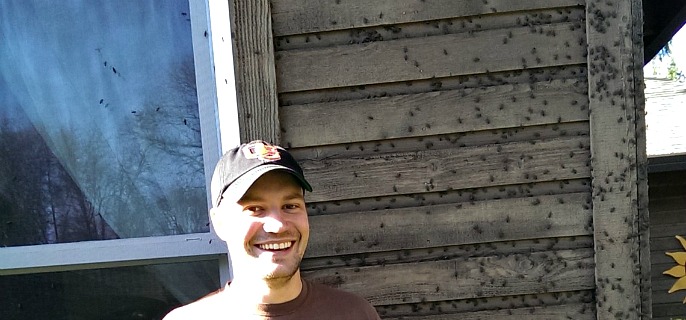
PHOTO COURTESY OF ODA
The welcome mat outside your home’s front door probably isn’t intended for all species of life, especially those with lots of legs. Nonetheless, many insects jump at the chance– or more likely crawl– to find a cozy shelter as winter approaches. Oregon homeowners and apartment dwellers may notice the usual increased indoor activity of insects associated with this time of year.
“During fall and winter, several insect species– both introduced and native– can enter homes in large numbers,” says Oregon Department of Agriculture entomologist Jim LaBonte. “They may be a nuisance but homeowners should not be overly concerned with these bugs. They are not a threat to humans, pets, or structures in any way, manner, or form.”
As temperatures drop and days become shorter, these insects can aggregate in houses and other structures. In nature, they seek winter shelter under loose bark, in rock crevices, rotten logs, and leaf litter. Unfortunately, human residences also work just fine as shelters. When such insects enter homes in large numbers, they can become what entomologists refer to as AHPs– aggregative house pests.
Because AHPs are relatively small– some species are very tiny– they can easily enter through gaps under and around doors leading outside, poorly fitting windows, dryer vents, and other points of access into a residence. While almost all species of AHPs feed on plants, they do not feed while overwintering and should not harm house plants. These insects do not reproduce while inside homes.
Keeping these bugs out in the first place is probably the best choice for residents.
“The best thing to do is to seal up points of access,” says LaBonte. “For bugs that have already entered the home, it depends on how many you have and your tolerance for AHPs. You can escort them outside, flush them down the toilet, or dispose of them as you see fit. If there is a large number of them, a vacuum cleaner works well. We don’t recommend calling a pest control company this time of year. First, these bugs aren’t harmful. You should be able to deal with them on your own. Secondly, your home is like an island in a sea of bugs. Spraying pesticides, might get rid of pests inside the house at that time, but others likely will come in and take their place, especially if you haven’t sealed the accesses.”
After a few hard frosts, the outdoor bugs will likely become very inactive or will have already found shelter for the winter. In either case, they aren’t likely to come indoors.
Several native species find their way into the home during winter, most commonly the box elder bug, Boisea rubrolineata, which normally feeds on maple leaves. ODA has received calls about the native western conifer seed bug, Leptoglossus occidentalis, a leaf-footed bug sometimes mistaken for the “conenose” or “kissing” bug. That bug is a species of assassin bug, which bites people, sucks their blood, and can transmit Chaga’s disease. However, “conenose/kissing” bugs are not found in Oregon.
House or ground spiders often enter homes this time of year, especially while seeking mates. These spiders are nothing to be concerned about, according to LaBonte. The only truly poisonous Oregon spider is the black widow, which is rarely common in residences except perhaps in Eastern or Southern Oregon.
It appears to be a normal year of indoor bug activity in Oregon. ODA is receiving fewer reports of brown marmorated stink bugs in homes, but that may be a sign of Oregonians just getting used to having them around. No matter the species, its normal for you to share your home this winter with insects whether you like it or not.








